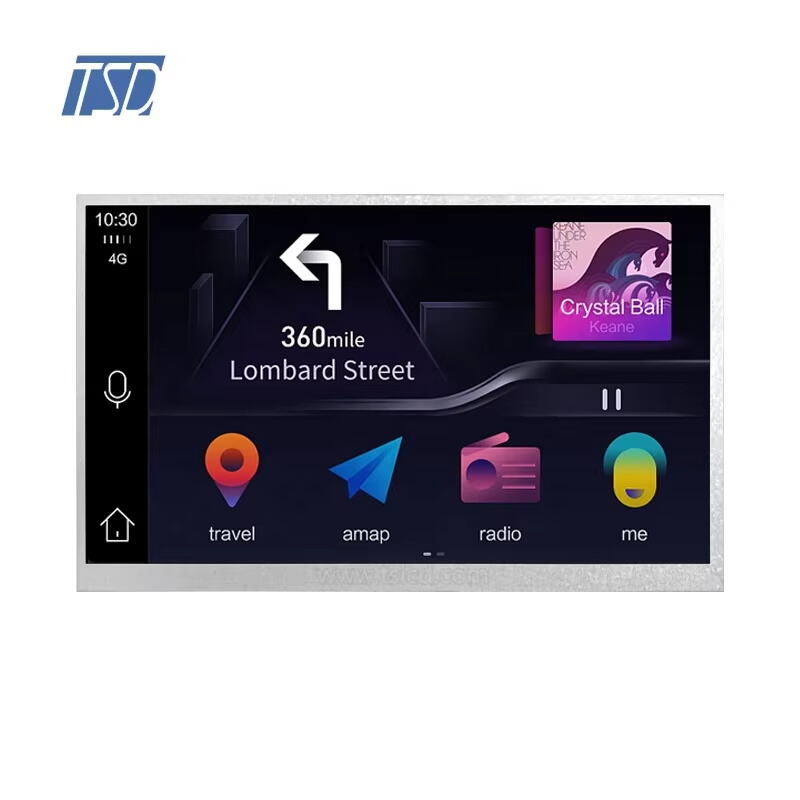אוטומציה בהרכבת פנלי LCD
מערכות אוטומטיות הפכו להיות חיוניות לייצור לוחות LCD מהירים ומדויקים יותר בפקולטות. מפעלים סומכים כעת בכבד על רובוטים ומכונות חכמות שפועלות באמצעות בינה מלאכותית על מנת לבצע את רוב המשימות בתהליך הייצור. המעבר הזה גורם לטעויות פחותות לאורך מחזור הייצור. חלק מהנתונים מצביעים על ירידה של כ-30% בשיעור הטעויות לאחר יישום השיטות החדשות. כלים נפוצים לאוטומציה במפעלי LCD כוללים את הזרועות המכאניקליות הארכות שממקדות רכיבים בדיוק, ואת מצלמות ההייטק ש escan כל לוח כדי לאתר פגומים. השיפורים האלה לא רק מזרזים את התהליך; הם גם מווסרים כי המוצרים הסופיים פועלים באופן מהימן כאשר הצרכנים מתחילים להשתמש בהם בבית או במשרדים.
טכניקות מהנדסות מדויקות
השלב של הנדסה מדויקת היא שונה לחלוטין כשמצמצמים את החריגה ומייצרים מסכי LCD באיכות גבוהה. יצרנים סומכים רבות על שיטות כמו גזירת לייזר ועיבוד באמצעות שליטה מספרית ממוחשבת במחזורים של ייצור. הטכניקות המתקדמות הללו מאפשרות להם ליצור חלקים בדיוק מופלא, עד לרמת המיקרון. כשעושים זאת כראוי, הנדסה מדויקת פירושה שכל רכיב משתלב בדיוק, מה שמפחית פגמים ומעורר את היצוא הכללי מהמפעלים. אנשי מקצוע בתעשייה דיברו על כך כבר שנים, וציינו עד כמה תשומת לב קפדנית לפרטים משנה את הדרך שבה מייצרים דברים במפעל. התוצאה הסופית? לוחות LCD אחידים ואיכותיים שצרכנים רוצים בהם, ושעוברים את כל הבדיקות הנדרשות כפי שהוגדרו על ידי הרשאות מוסמכות בשווקים השונים.
אימות רכיבים לפני ייצור
במקרים של מסכים נוזליים, בדיקת רכיבים לפני שהם נכנסים לרצפת הייצור היא חשובה במיוחד אם החברות מעוניינות בקבלת מוצרים אמינים ושñosרים לאורך זמן. תהליך האימות כולל מספר שלבים, בהם כל רכיב נבדק מול סטנדרטים מסוימים לפני המשך התהליך. יצרנים בודקים דברים כמו איכות החומר, תאימות ההפעלה בין הרכיבים, וכמו כן את תפקודם התקין בתנאים שונים. כאשר מפעלים מטמעים בדיקות אלו בשלבים מוקדמים, הם נוטים להפחית את מספר הפגומים בבערך 50 אחוז בשלב המתקדם, מה שעושה למוצר הסופי טוב בהרבה מקרים. חברות משתמשות באלפי כלים לצורך עבודה זו, לרבות תוכנת CAD ומכונות בדיקה אוטומטיות כדי להשיג תוצאות מקיפות מתהליך האימות.
בדיקת לחצי סביבה
בדיקת מסכים של LCD בתנאי לחץ סביבתיים נותרת הכרחית אם הם אמורים לשרוד כל מיני תנאים לאורך מחזור החיים שלהם. התהליך בפועל כולל יצירת מצבים הדומים למה שקורה במציאות – התייחסו לרמות של לחות, שינויי טמפרטורה פתאומיים ופגיעות פיזיות. יצרנים נוטים להכניס מסכים לתאים מיוחדים הממולאים ברוטב או לחשוף אותם לקור או לחום קיצוני. מה שנותן ערך למבחנים הללו הוא לא רק הבדיקה אם המוצרים ישרדו – הם למעשה מוכחים מהנדסים לפתח חומרים טובים יותר לאורך זמן. ניתוח דוחות תעשייתיים מגוונים מראה בבירור שכשחברות מתחייבות לבדיקות סביבתיות מקיפות, המוצרים שלהן מצליחים הרבה יותר בתנאים קשים. ההכנה הזו מאפשרת לייצרני מסכים לייצר מוצרים שממשיכים לעמוד בכל אתגרים שיווקיים קשים של ימינו.
הסכמה עם תקן איכות בינלאומי
דרישות תעודת ISO
קבלת תעודת ISO היא חשובה מאוד לחברה שמייצרת פנלים של מסך LCD, שכן היא מראה שהמוצרים עומדים בדרישות האיכות הבינלאומיות שלכולם יש עין. כדי לקבל תעודת התאמה זו, יצרני הפנלים חייבים לעקוב אחרי כללי ייצור קפדניים, לבצע בדיקות מקיפות על כל משלוח ולשמור על רמת איכות עקבית בכל תהליכי הייצור. היתרונות? אמינות גבוהה יותר של המוצר פירושה פחות מיחזורים, לקוחות מרוצים יותר שמבינים טוב יותר מה הם קונים, וכניסה קלה יותר לשוקים בינלאומיים. מעניין במיוחד, שבערך 70% מהמפעלים שעברו את תהליך האישור, ש verbesserung their market position לאחר מכן, לפי סקרים עדכניים. למרות שההתמודדות עם הניירות וה ביקורות יכולה להיות מעיקת, עמידה בסטנדרטים אלו עוזרת לייצרנים להתמודד עם תהליכי ייבוא/יצוא מורכבים ומבנית אמון אמיתי אצל קונים שמרגישים שතעודת ה-ISO היא סימן לנהלי ביקורת איכות נאותים.
ベン치מרק שגרתי
קיום מדדי איכות מובנים בתוך החברה תורם להحفاظ על מסכי LCD ברמת đỉnh. מה שחברות עושות בעיקר הוא ליצור מערכת משלהן של בדיקות איכות ומדדי תפעול כדי להשוות עם מה שעושים בתעשייה. הן בודקות דברים כמו ניקות המסך, אם הצבעים יוצאים כנדרש, וכמה זמן המסכים עמידים לפני שהם מתקלקלים. גם ראינו תוצאות אמיתיות. בואו ניקח כדוגמה מפעלים שממש משקיעים בבדיקה מול מתחרים מובילים - מקומות כאלה נוטים לראות ירידה משמעותית במוצרים פגומים. אחד המפעלים אפילו חצץ את אחוז הפגומים שלו לשניים אחרי שיחדש את שיטת השוואת המדדים. העניין המרכזי כאן הוא לשמור על מדדים אלו מעודכנים. כאשר הטכנולוגיה משתנה והדרישות של הלקוחות עולות, יצרנים צריכים לרענן מעת לעת את תקני האיכות שלהם אם הם רוצים להישאר קדימה בתחרות הגדולה בשוק ה-LCD.
ניהול שרשרת אספקה לאיכות LCD עקבית
קריטריונים לבחירת מקורות חומרים גלם
ייצור מסכים טובים מתחיל בחומרים גלם מתאימים כבר בהתחלה. על חברות לעקוב אחרי הנחיות די קפדניות בבחירת החומרים האלה אם הן מעוניינות שהמוצרים הסופיים שלהן יתפקדו היטב. דברים כמו ניקות החומרים, מהם החומרים הכימיים מהם הם מורכבים, ומה חוזק החומרים הפיזיקלי – כולם חשובים מאוד, שכן גורמים אלו משפיעים על תפקוד המסך, על משך השירות שלו ועל רמת וضوح התמונה. נתוני תעשייה מצביעים על כך שבחירת חומרים איכותיים יכולה להפחית את מספר הפגמים ב-20 אחוז בערך, וזה לא מיעוט. גם ייצור בשיטה ירוקה, כלומר בחירת חומרים בצורה אחראית, היא חשובה. כאשר יצרנים מפעילים גישה אחראית בחומרים, זה מועיל לסביבה ובעודו גם בונה ביטחון מצד הצרכנים כלפי המותג. אנשים נוטים לסמוך על חברות שמעורבות בקיימות, וככל שיש יותר אמון – כך גם תפיסת האיכות הכוללת של המוצר משתפרת.
ביקורות ספקים ושותפויות
בקרת איכות לאורך שרשרת האספקה כולה באמת תלויה ביצירת קשר קבוע עם הספקים. כשאנחנו מבצעים את הביקורים האלה, אנחנו פשוט מסתכלים על הסביבה שלהם, רואים איך הם פועלים מיום-יום, ובודקים אם הם עוקבים אחרי כל הנחיות האיכות שקבענו יחד. המטרה כולה היא לאתר כל בעיה עוד לפני שהיא הופכת לבעיה גדולה שמקשה עלינו את החיים בהמשך, כך שהמוצרים שלנו ישארו באיכות הגבוהה ביותר. גם חשוב לארגונים לפתח יחסים מקצועיים טובים עם הספקים שלהם. אמון משחק כאן תפקיד גדול, וכשספקי החומר יודעים שאנחנו מעריכים אותם, הם נוטים לספק תוצאות טובות יותר לאורך זמן. מחקרים מצביעים על כך שעסקים שממשיכים לעקוב אחרי הספקים שלהם באמצעות ביקורים קבועים ומביאים יחסים יציבים, רואים בדרך כלל שיפור באיכות המוצרים. חלק מהם אפילו מציינים קפיצה של כ-15 אחוזים ב שביעות רצון הלקוחות, כי פשוט אנשים מעריכים קנייה של מוצרים אמינים, בלי הפתעות.
באמצעות שילוב של פרקטיקות אלו באסטרטגיה של ניהול שרשרת האספקה, יוכלו יצרנים להשיג איכות אחידה בפלטת LCD, מה שיסתיים בשיפור סיפוק הצרכן וצמיחה עסקית.

אסטרטגיות שיפור רציף ביצור מסכים
ניתוח פגם ומעגלי משוב
שליטה בניתוח פגמים ומכניזמי המשוב היא שולטת כל ההבדל כשמטרתם לשכלל את איכות המוצר בייצור מסכים. כשחוקרים פגמי ייצור, יצרנים נאלצים להבין מה השתבש ולתקן את הבעיות עוד בטרם הן הופכות לבעיה גדולה יותר בהמשך הדרך. חברות רבות פונות לשיטות כמו שישה סיגמה כדי לעקוב אחרי הנקודות שבהן things נשברות במהלך סדרת הייצור ולעבוד בצורה שיטתית לשילוב תוצאות טובות יותר. בכל זאת, תקשורת טובה בין המחלקות היא הכרחית לחלוטין. ללא תקשורת חופשית בין הנדסה, בקרת איכות וצוותי הייצור, גם כלי האנליזה הטובים ביותר לא ישפיעו כמעט. מערכת המשוב מאפשרת לכלל מעורבי לשתף תצפיות באופן מיידי, כך שבעיות נפתרות מהר יותר ורעיונות חדשים לשילוב שיפור יכולים לצמוח בצורה טבעית מהתפעול היומיומי ולא רק מפגישות הניהול הגבוה.
השקעה במחקר ופיתוח לאופטימיזציה של תהליכי יצור
השקעת כסף במחקר ופיתוח היא מה שהופך להבחנה אמיתית כשמדובר ביכולת לייצור לוחות LCD טובים יותר. חברות שממקדות את תשומת הלב שלהן במעבדות המחקר והפיתוח שלהן נוטות לגלות דרכים חדשות לייצור מהיר יותר, תוך שמירה על רמת האיכות. בחינה של נתונים עדכניים מתחום ייצור המסכים מראה שעסקים משקיעים היום הרבה יותר במחקר בהשוואה לכמה שנים קודמות. קחו לדוגמה את סמסונג – הם הוציאו מיליונים בשנה שעברה על פיתוח שכבות זכוכית דקיקות יותר, מה שצמצם את בזבוז החומרים בתהליך הייצור. כששחקנים גדולים בתעשייה משקיעים משאבים משמעותיים בחדשנות, נוצרת תרבות שבה כולם מביטים כל הזמן אחרי שיטות טובות יותר. זה חשוב במיוחד בזירה מהירה של ציפיות הצרכן – אף אחד לא יכול להרשות לעצמו לעמוד במקום אם הוא רוצה להישאר תחרותי בשוק הזה.
אמצעי הגנה סביבתיים וחשמליים
אמצעי זהירות מפני סטאטיקה (ESD) בהרכבת LCD
הגנה מפני פריקת חשמל סטטי (ESD) במהלך תהליך ייצור מסכי LCD היא חשובה מאוד, מכיוון שאפילו מכה סטטית קטנה יכולה להרוס רכיבים עדינים. הדרכים העיקריות שבהן יצרנים מתמודדים עם הסיכון הזה כוללות חיבור ארוך של מכונות ועובדים, פרישת מגרשים אנטי סטטיים מיוחדים סביב תחנות העבודה, וכן ודואים שכל העובדים לובשים צמידי גוף שמחוברים לנקודות ארק. אל תשכחו גם שלשליטה ברמות הרطوبة בסביבת הייצור. כשחברות מטמעות באמת את הגנות ה-ESD האלה, הן נוטות להבחין בפחת באיכות בפסי הייצור שלהן. דוחי תעשייה מצביעים על כך שחברות שמאמצות פרוטוקולים קפדניים של ESD מצליחות להפחית את סוגיות אלו ב-40% עד 60%. הדבקה בסטנדרטים כמו IEC 61340 היא מה שקובע את ההבדל מבחינת הגנה עקבית מפני חשמל סטטי. מעבר לחיסכון בכסף שנובע מפסולת פגומה, ניהול ESD נכון מוביל בסופו של דבר ללוחות LCD בעלי ביצועים טובים יותר, שלקוחות יעריכו לאורך שנים לאחר הרכישה.
בדיקת עמידות לתנאים קשים
בדיקת מסכים של LCD בתנאים קיצוניים עוזרת לקבוע עד כמה הם באמת עמידים. יצרנים מ subjected מסכים אלו למגוון בדיקות על ידי חשיפה לשינויים קיצוניים בטמפרטורה, לחות רבה ופגיעות פיזיות שמדמות את מה שקורה בסצנות שימוש בפועל. התוצאות גם הן חשובות מאוד - כאשר מסכי LCD עוברים בדיקה קפדנית, שיעור הכשלים שלהם יורד בכ-40%. כלומר, הקונים מקבלים מוצר שיימשך לאורך זמן רב יותר. מחקר מצביע על כך שאנשים נוטים להיות מרוצים יותר ממסכים ששרדו טיפול קשה, מה שמסביר למה חברות ממשיכות להשקיע בהליכי בדיקה מקיפים. בסופו של דבר, אף אחד לא רוצה שהמסך שלו ית cracking אחרי מספר חודשים של שימוש רגיל. הבדיקות הללו מדגישות עד כמה זה חשוב לייצור מוצרים שמוכנים להתמודד עם כל אתגר, בין אם מדובר בנפילות אקראיות או חשיפה מתמדת לאור השמש בקונטרולים חיצוניים.
הכשרת עובדים להבטחת איכות יוצאת דופן
פיתוח כישורים טכנולוגיים מתמחימים
תוכניות הכשרה הממוקדות על בניית ידע טכני משפיעות על כל ההבדל כשמדובר בשמירה על איכות עליונה בייצור LCD. כאשר עובדים מקבלים הוראה נכונה על התעסוקה עם רכיבים רגישים ונהלים כמו הגדרת הגנה ESD כראוי, הם מצוידים טוב יותר לעבודה. היתרונות מופיעים מהר מדי קווי הייצור פועלים חלק יותר והצוות פועל טוב יותר יום אחרי יום. חברות שמשקיעות בסוגים אלה של הכשרה רואות תוצאות מוחשיות במבצעים שלהן.
תיאום קבוצת QC פונקציונלית
בתעשייה לייצור מסכים, צוותים פונקציונליים הם בעלי חשיבות מרכזית לשיפור של בקרת איכות לאורך קו הייצור. באמצעות איסוף אנשים מהנדסים, צוותי ייצור ומומחים לאיכות, יוצרים שיתופי פעולה טובים יותר בין מחלקות, מה שמוביל להשפעה ישירה על איכות המוצר הסופי. כאשר מהנדסים מדברים בקביעות עם עובדים בייצור ובקרת איכות, ניתן לתקן בעיות במהירות רבה לפני שהפאנלים הפגומים מגיעים ללקוחות. לשיטה זו יש גם יתרונות ממשיים לייצרנים. תקשורת זורמת בצורה חלקה יותר כאשר כל אחד מכיר את מה שעושים האחרים, פתרון של בעיות נעשה מהר יותר במקום להתקע בבירוקרטיה, וכן יש שיקוב טוב יותר לאורך כל תהליך הייצור. התוצאה הסופית? מסכים באיכות גבוהה יותר שיוצאים מהקו, וגם סביבת עבודה שבה אנשים תמיד מחפשים דרכים לשפר את מה שהם עושים. לקוחות מרגישים את ההבדל הזה בשימוש היומיומי במסכי LCD.
שאלות נפוצות
איזה תפקיד ממלאת האוטומציה בתעשייה לייצור מסכים נוזליים (LCD)?
אוטומציה בייצור מסכים מישוריים מגבירה את היעילות והדיוק באמצעות שימוש במכשורים ובבינה מלאכותית כדי לאפשר תהליך ייצור חלק יותר, להפחית שיעורי טעויות ולשפר את שליטת האיכות
איך הנדסת דיוק תורמת לדיוק באיכות המסך המישורי?
הנדסת דיוק מבטיחה דיוק גבוה בעיצוב רכיבים, מפחיתה פגומים ומשפרת את הביצועים והผลיות תצוגת המסך המישורי
למה אימות רכיבים לפני הייצור הוא חשוב?
אימות רכיבים לפני הייצור מאמת כי הם עומדים בדרישות הדרושות לפני תחילת הייצור, מפחית באופן יעיל את מספר הפגומים ומשפר את נח reliabilityות המוצר
מהו מטרת בדיקות לחץ סביבתי במסכי LCD?
בדיקות לחץ סביבתי מדמות תנאים מהעולם האמיתי כדי לוודא שהמסכים המישוריים שומרים על תפקוד ועמידות לאורך מחזור החיים שלהם
למה תעודת ISO היא חשובה לייצרני LCD?
תעודת תקן ISO מבטיחה עמידה בסטנדרטים בינלאומיים לאיכות, ומעודדת את האמינות וההתחרותיות של המוצר בשווקים העולמיים.




